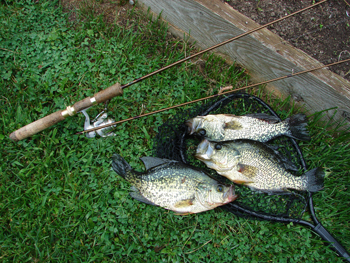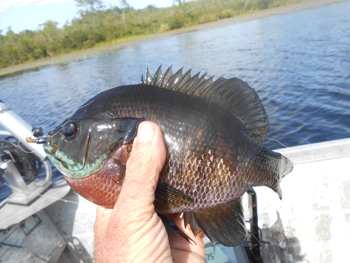Exotic Fish Species Come to Maine
by Tom Seymour

Black crappies grow to upwards of 3 pounds here in Maine, although most individuals weigh in closer to the 1-pound mark. Nonetheless, black crappies are aggressive feeders and willingly chase minnows, spinners and panfish jigs. Photo by Tom Seymour.
When hearing the word, “exotic,” images of the tropics come immediately to mind. But in the case of fish species, any non-native fish that gets introduced, either purposely, by the Maine Department of Inland Fisheries And Wildlife (DIF&W), or by illegal introduction, are considered as exotic species.
For years, Maine anglers have enjoyed pursuing brown trout, a European species brought here in the late 19th century. Rainbow trout, a later introduction brought to Maine from western states, have in recent years proven their worth as providing more-than-ample angler return.
The DIF&W manages these two exotic species of trout and both are raised in state-operated hatcheries from whence they are distributed throughout their allotted range.
Brown trout and rainbow trout are both salmonids, coldwater species. But other types of fish swim in Maine waters and some of these were never intended to become established in Maine. Spiny-rayed fish are warmwater species and exhibit a remarkable fecundity in that once established, they are more than able to grow their populations without the necessity of regular stocking.
In fact, the two species at the center of this article, black crappie, Pomixis nigromaculatus, and bluegill sunfish, Lepomis macrochirus, are both present in Maine, primarily through illegal, unsanctioned stocking.
Black Crappies
Black crappies were present in the Sebago drainage as far back as the 1950s. Another early introduction, this time in the Sebasticook River drainage, came about accidentally in the 1960s. The DIF&W had begun its largemouth bass (another exotic species) program and was in the process of stocking bass fry into suitable locations where they would not interfere or compete with native species.
Unfortunately, one shipment of out-of-state bass fry intended for the Sebasticook system contained crappie fry as well. The error was not identified until it was too late. Black crappie had already been released into the system and have since expanded their range throughout the region.
Black crappies were
present in the
Sebago drainage as
far back as the 1950s.
Once black crappies become established in a body of water, there exists no way to successfully eradicate them. These are the negatives regarding black crappies. Now to the positive side.
Black crappies exist in often-huge schools. Rarely do anglers take individual crappies on a one-here, one-there basis. Usually, upon catching one crappie, many more are sure to follow.
Black crappies have a rounded, flattish, or, “compressed,” body, tall dorsal fin, roundly forked tail and a huge mouth, which gave rise to the term, “bucket mouth.” Southern anglers also refer to them as “slabs.” Crappies routinely prey upon baitfish and warmwater ponds and lakes with a healthy population of golden shiners, a common baitfish, make perfect black crappie habitat.
Black crappies grow to upwards of 3 pounds here in Maine, although most individuals weigh in closer to the 1-pound mark. Nonetheless, black crappies are aggressive feeders and willingly chase minnows, spinners and panfish jigs.
Once hooked, crappies make a series of short, but spirited runs. In playing a crappie, care must be taken to not pull back too hard, in case the hook is only stuck to either side of the paper-thin sides of the mouth. Larger specimens are best landed by virtue of a landing net.
Since black crappies exist in Maine primarily through the efforts of the, “bucket brigade,” those who illegally release crappies in waters where they were never intended to exist, Maine places no size or bag limits upon them. That means an angler may catch hundreds of these gamey fish per day, if so desired.
Even better, black crappies have excellent-tasting flesh. The best way to prepare crappies is to skin and fillet them. The author prefers crappie fillets rolled in Cajun-style, fish coating mix and fried to a golden brown.
Given black crappies relatively small size, light tackle is recommended. The author uses ultralight spinning gear and no more that a 4-pound test line. This allows the fish to put on the most spirited battle.
Black crappies aren’t going anywhere and since they have become so plentiful in the Midcoast and Central Maine regions, anglers have every reason to pursue them. Sporty, plentiful and usually willing to bite in numbers, these newcomers have become the basis for a new sport fishery despite their illicit beginnings.
The best way to learn which waters in your local area hold black crappies is to contact the district, DIF&W fisheries biologists. These people are intimately familiar with everything that swims or crawls in their regions. Contact information for DIF&W administrative regions are found on the inside back page of the annual, Maine Fishing Laws booklet.
Bluegill Sunfish

Running a bit smaller than black crappies, a large Maine bluegill sunfish would measure about 12 inches. A few individuals reach larger sizes. Photo by Tom Seymour.
A newer introduction, this one totally due to illegal stocking, bluegill sunfish now thrive in the Sheepscot River drainage. This drainage encompasses countless streams and ponds. Bluegills, once established, immediately go about expanding their range. Any stream, thoroughfare or trickle leading from a crappie water to any other water can serve as a vehicle for bluegill movement.
While Mainers have yet to embrace bluegills to the extent they have black crappies, that may soon change. Bluegill sunfish comprise one of America’s more popular fisheries and in states to the south, bluegills are a much-sought sport fish.
Running a bit smaller than black crappies, a large bluegill would measure about 12 inches. A few individuals reach larger sizes. Since Maine water is generally colder than water in bluegill’s natural range, the fish do not grow as fast as those in more southerly climes. But lack of angling pressure has allowed Maine bluegills to attain their maximum size without being harvested by anglers.
Those few who do recognize bluegill sunfish as a valuable, if illegally introduced, sport fish species, have an open playing field.
Unlike black crappies, bluegills live in loosely formed schools and individual fish will live in one small area of a pond or lake, effectively spacing themselves from others. A small cove may harbor a dozen or more bluegills and these are easily taken by anglers using panfish jigs, earthworms and even small, fly-rod poppers.
Bluegills, like crappies, will aggressively attack a lure or bait. And once hooked, bluegills put up a battle worthy of far larger fish. One trademark of a bluegill on the line is the short bursts of energy, followed by the fish running in a circular pattern.
Bluegill sunfish
comprise one of
America’s more
popular fisheries.
Maine has several native sunfish swimming in her waters and among these are pumpkinseed sunfish and redbelly sunfish. Now here is a negative point regarding the bluegill invasion. While it would be difficult for bluegills to out-compete native sunfish for forage (warmwater ponds are incredibly fecund and hold more insects and small baitfish than might be imagined), they can diminish the native strains through hybridizing.
Bluegills will mate with pumpkinseed sunfish and the progeny becomes a rather distinct fish in its own right. Bluegill/pumpkinseed hybrids exhibit the same characteristics as full-blood bluegills.
Black crappies tend to hang near underwater structure such ledges and rocky points. Bluegill sunfish, on the other hand, rarely exist in water deeper than 25 – 30 feet and are primarily found in shallow, weedy areas.
Thus someone fishing from shore has every opportunity to load up on bluegill sunfish.
In this day and age of large, fully equipped boats, the majority of anglers spend most of their time fishing for larger fish species such as trout, lake trout and landlocked salmon. This is not the case in other states, where anglers purposely target bluegills. Here in Maine, bluegill sunfish remain mostly unsung and even rather mysterious.
Anglers in small boats and canoes are perfectly equipped to pursue bluegill sunfish, since there is no need to head out to the middle of a lake or pond. Fishing near-shore locations, often casting to within a foot of shore, accounts for the majority of bluegills taken.
In spring, the shallows become alive with spawning and post-spawning bluegills. Later in summer, most fish head for slightly deeper water and are taken in the 15- to 20-foot depth range.
Like black crappies, bluegill sunfish have rounded, extremely compressed bodies. The sides are marked with vertical bars. Bluegills have very small mouths, so small baits and lures make the preferred offerings.
Again, as with black crappies, contact a DIF&W biologist for more information on what waters hold bluegills. And remember, these fish are constantly expanding their ranges and were they existed in one place several years ago, they have most likely spread out to other, connected waters.
Also, preparation involves the same process as with crappie. That is, skinning and filleting. After catching his first batch of bluegills several years ago, the author recalled that the late Euell Gibbons had mentioned bluegill sunfish in one of his books. So looking at Gibbons’ notes, one recipe seemed worth trying. That was dipping bluegill fillets in a Tempura batter and frying until brown.
This made a perfectly elegant meal and this cooking method comes highly recommended.
Maine is now home to black crappies and bluegill sunfish and they can never be eradicated. So instead, let us accept them for what they are; sporty, abundant panfish that can give us hours of angling pleasure while providing the fodder for some of the finest fish-fries.
